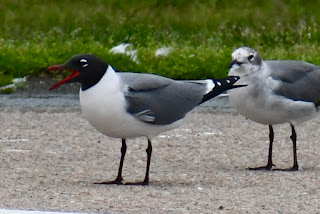6/2/2025 - 2,500 Consecutive eBird Days and a Miss in Rhode Island
This past Saturday I reached 2,500 consecutive days with at least one eBird checklist. There are no awards or accolades for this, same as it is for those who must end the year with the most species for the county. The streak is just a personal milestone, and I get to share some stats here as well.
This streak started nearly seven years ago (6.84 to be more precise). Mid-January of last year is when I hit 2,000 consecutive days. In the past 500 days, I have submitted 922 checklists. The checklists covered eight states and two oceans. I listed around 340 different species, including eight new life birds. The eight new birds were: white-throated swift, Swinhoe’s white-eye, black oystercatcher, mitred parakeet, cave swallow, tundra bean-goose, Lazuli’s bunting and Bell’s vireo.
Left, Swinhoe's white-eye in Manhattan Beach, CA. Right, mitred parakeet in Long Beach, CA. © S. Weiss
Northern red bishop in San Diego, CA. © S. Weiss
I was actually hoping that day 2,500 would have been a memorable one with a new life bird, but I came up short on the life list. I was in Rhode Island during the weekend, and it just so happened that a Franklin’s gull was in the area. I have been trying to get my eyes on this laughing gull look-alike, but this latest attempt was no different than previous ones. The bird was seen earlier in the day on Friday at Misquamicut State Beach. That happened to be on the way to where I was heading. I arrived there about midafternoon. They claim the beach is free, but parking is not, and the bird had been hanging out in the parking lot.
It’s hard to talk your way through the gates without paying when the plates on your car make it obvious, you’re not from around those parts. I paid the fee and joined a few others looking for the gull, including the person who originally found the bird. My wife was patiently sitting in the car, so my time was limited. We checked out every laughing gull there, with birds coming in and leaving the flock, but we could not make one a Franklin’s gull. After about an hour, I left to continue on to my daughter’s apartment, but I still had another day to try for it.
Saturday morning, before heading out to look for something interesting, I checked the eBird reports for updates on the gull. Someone reported seeing it late Friday after I had left, and someone else had already reported it Saturday morning. Neither person had photos, and the best descriptions they gave were vague, something like: “white arcs around eyes,” “spots on wing tips.” Not much different from a laughing gull really. I shrugged them off as cases of misidentification. But as I was driving to one destination, I thought “What if one of them was right?” By then I was already halfway from the state beach, so I headed back there. I would rather go there and not see it, then not go and the bird be there. Well, the first part of that last sentence turned out to be the case.
Laughing gulls. © S. Weiss
Left, in flight the primaries are clearly visible in this laughing gull. They are mostly black. In a Franklin's gull they would be mostly white. Right, this laughing gull has spots on its folded primaries, but not on the tips. On a Franklin's gull they would be large and covering most of the primaries, including the tip. The bills on these birds are longer than on a Franklin's gull. Franklin's gulls have bold eye arcs, but so do these gulls. Franklin's gulls have a pink tinge to their breasts; though these gulls don't, many laughing gulls show a weak pink tinge too.
Bonaparte's gull. © S. Weiss
This gull is smaller than the surrounding laughing gulls. Its outer primaries are mostly white, and its bill is shorter and straighter than the laughing gulls.
Another local was already there and had no luck. I was there for another hour or hour-and-a-half and the two of us scrutinized every gull there that could potentially be a Franklin’s. The bird was in alternate plumage, so that narrowed it down to just those with full black hoods. Then, we narrowed it down more by ignoring those that had no spots on the primaries. Some of the laughing gulls also had a pink tinge to their breasts like Franklin’s do. None of the gulls hit all the field check marks for our target bird. The Franklin’s gull eluded me again.
We left Rhode Island Sunday morning with my streak at a new milestone, but without a new bird. I don’t know how or when the consecutive days of eBird checklists will end. But the next milestone, 3,000 days, should come mid-October next year. Hopefully, Franklin’s gull will be part of those stats.









Comments
Post a Comment